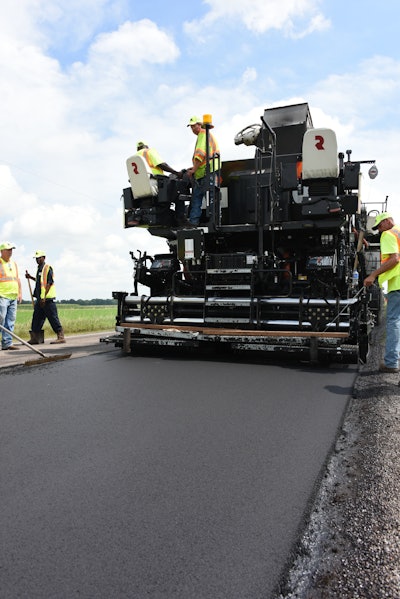
After several years in the making, NCAT, the National Center for Asphalt Technology under the auspices of Auburn University and the National Asphalt Pavement Association (NAPA), has taken its expertise, and an assemblage of equipment and personnel up to one of the coldest parts of the country to determine some of the best methods of pavement preservation in cold weather climates.
The 528-foot long test strips (.10 mile) will be exposed to low and high volume traffic in the central part of Minnesota where minus-30 Fahrenheit temperatures can last for days at a time, and plows scrape the snow and ice directly off the pavement without the assist of plow shoes. Along with these conditions are the detrimental freeze/thaw cycles that most northern states and northern sections of the world face and experience, much to the chagrin of transportation managers in the state Department of Transportation agencies down to the motoring public who experience firsthand those effects.
The freeze/thaw cycle creates cracks in the asphalt that commonly occur across an entire lane when the ground and asphalt contracts during below freezing temperatures and then goes back to “normal” temperatures creating a chasm at the asphalt surface. This condition can be worsened by many changes in temperature during the course of the winter season or over the course of years of plowing, salt use for vehicular safety and change of permafrost conditions among other circumstances of unusual heavy truck loads or typical road deterioration.
The objective of the study in conjunction with the Office of Materials and Road Research under the Minnesota Department of Transportation (MnDOT) is to quantify the life extending benefit of different preservation treatments in the northern climate. The 13 hot mix test sections mirror the NCAT test tracks located in Alabama where temperatures don’t reach below freezing for long periods of time and snow seldom falls enough to plow. All of the sections are thinlays of one inch or less (usually ¾” thick) that have become an important tool in the tool box for program and asset managers who have an infrastructure that needs to be maintained and preserved.
Thinlays can extend the road’s life before major reconstruction has to take place. It also extends the monies spent on roads by paving more roads with the same money available that seems to be shrinking in today’s economic state coffers by paving only a thin asphalt layer instead of the past common 2-inch-thick asphalt mat. Different formulas including rejuvenators have been designed with the help of other state agency feedbacks along with different methods that these bureaus favor or are considering in their own states.
It takes a village
To accomplish the tests in the Pease – Milaca, Mille Lacs County area on routes CR-8 for low volume (1000 vehicles daily), and US-169 for high volume (up to 25,000 vehicles daily) traffic a multitude of entities helped. State and private agencies, equipment manufacturers who have worked hard to make this project happen to benefit the whole industry, and contractors, have donated their time, effort and equipment to get the test strips laid over just several days during the height of the summer season in 2016.
Observation of pretreatment conditions, after milling procedures (to maintain crown, grade and cross slope), and the asphalt laid, only encompassed a portion of the test. Mapping and documenting ongoing conditions for the next three to five years will also occur.
The logistics to bring this project together meant bringing in a crew of 16 people from Alabama, specifically East Alabama Paving of Opelika, AL. who has worked with NCAT Project Manager Buzz Powell since 2002. They are versed in his procedures for laying the various test strips.
The southern test track known as the NCAT Pavement Test Track has been built/rebuilt six times over his past 17 years there, yet this is the first time a significant partnership has been established, in this case with MnDOT (Minnesota Department of Transportation) to expand the evaluation of pavement performance in both the northern and the southern climates. It should provide cost-effective solutions that can be implemented nationwide, according to the joint task force.
“It’s a logical progression in developing and evaluating new sustainable technologies, pavement systems and construction methods that lead to safer, quieter, lower cost and longer lasting roads,” states the partnership mission. Pavement systems may be in the form of using a Roadtec SP-200e Spray Paver, favored by several agencies, or in the use of micromilling as a construction method before a thinlay is placed. Additives may enhance a mix by using a rejuvenating plant based Delta S liquid chemistry utilized in high RAP-RAS content asphalt mix designs to help prevent premature cracking of the pavement, as an example.
Although MnDOT has their own test track in Albertville, MN, this opportunity gives NCAT the ability to compare mix designs, methods, materials, and performance in both climates, since it will mirror 13 other identical test sections at Auburn, AL. This will give transportation managers more data and choices as to what can be the best method for their unique or extenuating circumstances “"n their neck of the woods."
To accomplish this project that includes close scrutiny of pavement preservation techniques and cracking prediction for common distress in colder climates, Astech Corp. (a Minnesota contractor), and Madden Contracting Company Inc. donated and volunteered their resources, along with Sakai America and Caterpillar bringing in their own products to help lay the best possible asphalt mats, one tenth of a mile at a time.
Madden Contracting Company Inc. of Shreveport, LA shipped its Roadtec SP-200e Spray Paver north, since it serves the needs of all the test strips with or without the spray bar being utilized. Two of the cells will be utilizing the Spray Paver on a virgin and a recycled ultra-thin bonded wearing course. The advantages for the paver putting down the thin lifts this way are many. No trucks, material transfer vehicles or paver tracks contaminate or take the emulsion away from the cleaned, sprayed road surface if done conventionally. No vehicular traffic picks up the tack coat in the wheel rut surface since the tack coat is sprayed just inches in front of the asphalt being placed by the augers.
“When the asphalt hits the oil, it immediately steams the water out of the oil, which make it bond extremely fast to the surface you are paving. It also pulls part of the oil up into the asphalt that you are laying and creates a super adhesive bond that establishes a good durable product on the road. The shot rate can be varied based upon your needs and emulsion width is more precise to just where the asphalt is being placed,” explained Dave Bussard, Service and Field Technician for Roadtec. Bussard was part of a group of five Roadtec technicians, spearheaded by Richard Kramer to make sure their equipment would be running properly during all different test mixes and methods.
Local contractor, Astech Corp. (Asphalt Surface Technologies Corporation) of St. Cloud donated its SB2500 Shuttle Buggy to feed the Spray Paver SP-200e during the hot mix test session. Even though it was done during the firm’s short paving season, President Bruce Batzer felt the need to contribute what he could, since he would benefit from what was being done in his area of work. As a pavement preservation company who works in Minnesota and the surrounding states with micro surfacing crews, crack repair crews, and the ultra-thin bonded wear course crews, Batzer realizes the need for improved roads. He also provided his crews to direct traffic, including a pilot car on the low volume road of CR-8.
Hardrives Inc. of St Cloud and Becker, MN used their 350-ton asphalt plant to make the 13 different mixes with different designs from UTBWC, ARB, OGFC, Virgin, to HiMA, 32 tons at a time. Hardrives’ drivers made sure that both NCAT and MnDOT received samples of each mix for further testing, as to determine that each mix was spot-on according to specific formulation. Even after a 45-minute haul trip, asphalt mixes ranged in the 246º to 258º F temperature range.
Sakai America contributed two double-drum rollers for the duration, along with District Manager David Koerkenmeier guiding and instructing operators on the use of the SW 770HF (67” width) and SW 654 (58” width) rollers that would final compact the newly laid asphalt. Caterpillar donated its rubber-tired CW 34 wheel roller as well.
Collaborative Aggregates is sponsoring a Delta S applied research section at both climate locations to provide them real traffic, cold weather climate, asphalt pavement performance data points compared to the more temperate climate conditions offered at the Alabama location. That information will be eventually disseminated and used worldwide.
Lower life cycle costs
Currently, about 19 states are sponsoring these projects, more than half a dozen from northern states. Yet all states can benefit from these experiments and written results.
“We’ve never been able to provide guidance to the state DOTs on thermal cracking and snow plow damage because that is unique to the climates that are up in the extreme north," says Buzz Powell, assistant director at the NCAT. "So what we’re doing is essentially duplicating our off-track pavement preservation test sections in the south to those in the north. We have both a low traffic road (Lee Road 159) and a high traffic road (US-280) with a set of preservation treatments including plant mix and emulsion treatments. The objective of the study is to quantify the life extending benefit of different preservation treatments.
“Or, in other words, what is the unique life extending benefit of each one of these stand-alone treatments and treatment combinations in terms of pavement preservation," he continues. "Once we quantify those benefits, the life extending and condition improving benefits, then the agencies can make decisions on what treatments they want to use strictly based on the life cycle cost scenarios that are local to their jurisdiction. The resulting set of curves produced from the southern climate and then the regional shift to the northern climate can help others make objective decisions, particularly transportation system managers, to eventually provide the tax payer the best product with the lowest cost possible.
“There are several things you can do to achieve that same level of high quality, but the Spray Paver is the standard to which other methods are compared," Powell continues. "Anything you’re trying to do, you’re really trying to achieve that same level of quality that’s achievable with the Spray Paver."
Jeff Brunner, Pavement Research Director for MnDOT was on hand to observe and assess the project. Other materials and road research personnel, including Jerry Geib, research operations engineer, and Paul Nolan, research project supervisor, also did core sample testing and will do future testing with monitor equipped vehicles specifically to determine the infrastructure developments after the cold, snowy winters.
“These tests are important to our state and others in an obvious manner," says Brunner. "The better the treatments, the longer that our pavements can last, which in turn saves us dollars. Not only that, but the disruption in construction can be a major headache to the traveling public, so the less we need to be out there to maintain proper traffic flow, the better. Then there is the cost, the life cycle cost of the pavements. Hopefully we can stretch those things out and have less cost to the taxpayer."
NCAT as well as MnDOT’s goals of "finding ways to make roads last longer, perform better, cost less to build and maintain, be built faster and have minimal impact on the environment" are desired by every participant involved. Performing these tests in Mille Lacs County is certainly toward those goals, while creating a win-win situation for all contributors, but ultimately it is a very big win for the tax paying public.



















